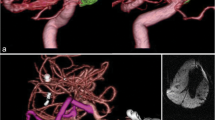Abstract
Background
Microsurgical clipping of previously coiled intracranial aneurysms can be technically challenging. We present the case of a 48-year-old female with a partially coiled, previously ruptured giant middle cerebral artery aneurysm and the associated technical nuances.
Methods
We performed a successful coil extraction and clip reconstruction of this aneurysm using an ultrasonic aspirator and stacked fenestrated aneurysm clips.
Conclusion
Coil extraction and clip occlusion of previously coiled intracranial aneurysms is a complex and technically challenging procedure but can be performed safely and effectively when employed judiciously.




Similar content being viewed by others
References
Badih D, Nohra C, Robert MS, Guilherme B, Yq L, John D, Stavropoula T, Robert HR, Pascal J (2016) Clipping of previously coiled cerebral aneurysms: efficacy, safety, and predictors in a cohort of 111 patients. J Neurosurg 125:1337–1343. https://doi.org/10.3171/2015.10.JNS151544
Brinjikji W, Lanzino G, Cloft HJ, Rabinstein A, Kallmes DF (2011) Endovascular treatment of middle cerebral artery aneurysms: a systematic review and single-center series. Neurosurgery 68:397–402; discussion 402. https://doi.org/10.1227/NEU.0b013e318201d7f4
Gandhi S, Mascitelli JR, Zhao X, Chen T, Hardesty DA, Wright EJ, Lawton MT (2019) Two-stage revascularization and clip reconstruction of a giant ophthalmic artery aneurysm: 3-dimensional operative video. Oper Neurosurg (Hagerstown) 17:E110–e111. https://doi.org/10.1093/ons/opy383
Gibo H, Carver CC, Rhoton AL Jr, Lenkey C, Mitchell RJ (1981) Microsurgical anatomy of the middle cerebral artery. J Neurosurg 54:151–169. https://doi.org/10.3171/jns.1981.54.2.0151
Johnston SC, Dowd CF, Higashida RT, Lawton MT, Duckwiler GR, Gress DR (2008) Predictors of rehemorrhage after treatment of ruptured intracranial aneurysms: the Cerebral Aneurysm Rerupture After Treatment (CARAT) study. Stroke 39:120–125. https://doi.org/10.1161/strokeaha.107.495747
Raymond J, Darsaut TE (2011) An approach to recurrent aneurysms following endovascular coiling. J NeuroInterv Surg 3:314. https://doi.org/10.1136/jnis.2011.004788
Shtaya A, Dasgupta D, Millar J, Sparrow O, Bulters D, Duffill J (2018) Outcomes of microsurgical clipping of recurrent aneurysms after endovascular coiling. World Neurosurg 112:e540–e547. https://doi.org/10.1016/j.wneu.2018.01.077
Sughrue ME, Saloner D, Rayz VL, Lawton MT (2011) Giant intracranial aneurysms: evolution of management in a contemporary surgical series. Neurosurgery 69:1261–1271. https://doi.org/10.1227/NEU.0b013e31822bb8a6
Wiebers DO (2003) Unruptured intracranial aneurysms: natural history, clinical outcome, and risks of surgical and endovascular treatment. Lancet 362:103–110. https://doi.org/10.1016/S0140-6736(03)13860-3
Woertgen C, Rothoerl RD, Albert R, Schebesch KM, Ullrich OW (2008) Effects of temporary clipping during aneurysm surgery. Neurol Res 30:542–546. https://doi.org/10.1179/174313208x291603
Author information
Authors and Affiliations
Corresponding author
Ethics declarations
Conflict of interest
The authors declare that they have no conflict of interest.
Additional information
Key Points
• During the approach to complex, previously coiled MCA aneurysms, be cognisant of the potential requirement for an EC-IC bypass and preserve the superficial temporal artery
• Opening of the aneurysm and coil extraction should only be attempted when attempts at simple clip application have failed
• The ultrasonic aspirator is a useful tool for breakdown of thrombus and coils and facilitating extraction of the coils
• Delay temporary clip application until most of the thrombus and coils have been extracted to limit temporary clipping time
• Stacked fenestrated clips are useful in the occlusion of thick-walled aneurysms, which may cause splaying of the blades of non-fenestrated clips and allow ongoing aneurysm filling
• Indocyanine green angiography is essential in order to confirm the patency of the MCA branches.
• Complex MCA aneurysms have high rates of recurrence following endovascular treatment, and surgical intervention should be considered as a primary treatment modality in these cases
Publisher’s note
Springer Nature remains neutral with regard to jurisdictional claims in published maps and institutional affiliations.
This article is part of the Topical Collection on Vascular Neurosurgery - Aneurysm
Supplementary Information
Rights and permissions
About this article
Cite this article
Hannan, C.J., Javadpour, M. How I do it: coil extraction and clip reconstruction of a previously coiled giant middle cerebral artery aneurysm. Acta Neurochir 163, 2363–2366 (2021). https://doi.org/10.1007/s00701-021-04727-0
Received:
Accepted:
Published:
Issue Date:
DOI: https://doi.org/10.1007/s00701-021-04727-0




